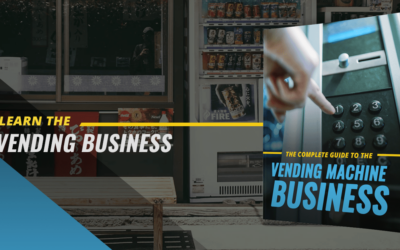Welcome to the complete guide to the vending machine business. How The Vending Machine Business Work How to Make Money In Vending Strategies to Find Profitable Vending Locations How to Service A New Vending Account – Part 1 How to Service A New Vending Account – Part...
The Vending Business Blog
How to find the Most Profitable Vending Machine Locations
May 21, 2018 | Start A Vending Machine Business, Vending Business Show
The Importance of Vending Machine Locations The right vending machine locations give you a greater chance of sales. Here's our 4-step process to get an establishment to agree to host your machines. Vending Machines generate $20 billion to $30 billion annually....
Vending Machine Business : Making Profit With An Ice Cream Vending Machine
Jul 13, 2017 | Start A Vending Machine Business, Vending Business Show
Vending Machine Business: Making Profit With An Ice Cream Vending Machine Starting a vending machine business provides many benefits. Starting a vending machine business offers the luxury of working less than one day per week while receiving those same benefits. The...
Acquiring New Vending Accounts
Jul 28, 2015 | Vending Business Show
Acquiring new vending accounts is easy you just need to have a plan.. You can acquire new vending accounts through contacting a large vendor. Large Vending Companies like to send business they don't want to someone they can trust usually because they have size...
Intuition and Vending Sales
Jul 21, 2015 | Vending Business Show
Intuition and vending sales. If you think you need to go talk to somebody on your prospect list, you probably ought to. Intuition and vending sales go hand and hand. Listen to that small voice that nudges you to contact someone even if you don't know why, there's...
Take Your Vending Business To The Next Level Part 2
Jul 14, 2015 | Vending Business Show
Take Your Vending Business To The Next Level Part 2 Larry shares how he landed a profitable vending account from his early days. Soon after landing this account he received phone calls from every facility they had in the area. To get into big accounts you find...
Vending Sales Large Accounts
Jul 7, 2015 | Vending Business Show
Larry shares a story about Vending Sales Large Accounts Vending Sales Large Accounts or taking it to the next level involves persistence because big accounts get called on by most sales people.usually once or twice a month. Vending Sales Large Accounts is just as...
Vending Sales Networking
Jun 30, 2015 | Vending Business Show
Vending Sales Networking Vending Sales Networking is a company that already sells a service or product to a potential customers to a potential account that you might want? Uniform Companies, Office Supply Companies . Office Coffee Services, Staffing Companies,...
How To Choose A Refurbished Vending Machine
Oct 14, 2014 | Machines, Vending Business Show
If you are interested in finding the best refurbished vending machine, you'll want to ask yourself these questions; watch the video. Let's assume you want a reliable machine that's easy to maintain with...


